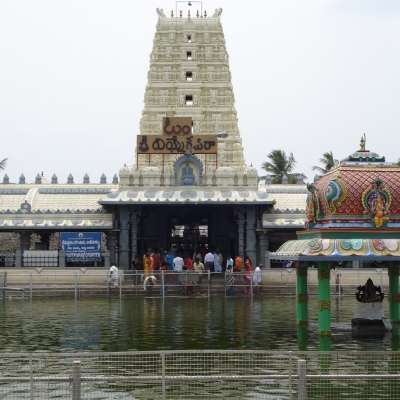
Srikalahasteeswara Temple - India
Srikalahasteeswara Temple in Andhra Pradesh is an awesome yet powerful temple where you can feel the divine presence of Lord Shiva bestowing his blessings upon you. If you are an ardent devotee of Lord Shiva, Srikalahasteeswara Temple is a glorious temple for you to visit in your lifetime.
The picture-perfect view of Srikalahasteeswara Temple with the gorgeous Swarnamukhi river flowing beside and the enchanting hillocks that run all around makes the place visually delightful.
This auspicious Temple is associated with Rahu and Kethu (two of the nine planets in Indian Astrology) and is famous for conducting rituals related to horoscopes like Rahu-Kethu Sarpa Dosha Nirvana Pujas.
The marvelous architecture, as well as the fantabulous temple sculptures, steals the show at Srikalahasteeswara Temple. Most of the temple sculptures reflect the mind-blowing brilliance of Chola architecture.
Lord Shiva who is fondly known as Lord Kalahasteeswara is worshipped here in the form of a lingam which represents Vayu or Air. There is also a shrine for Goddess Parvati who is worshipped as Gnana Prasunambika Devi.
Inside the Temple there is a cradle with Lord Siva and Parvati together on it which spreads a godly ambience and will make you look at it with great admiration. The lamp inside the inner sanctum of the temple that glows brightly even though there is no air vent inside the chamber will take you by surprise.
Visiting the historically and religiously significant Srikalahasteeswara Temple is a great experience as well as the night view of the temple and its surroundings is a luxuriate feast for the eyes.
History :
The most prominent legend about this temple is of Goddess Parvati who was cursed by Lord Shiva for discarding her heavenly body and assuming the human form. Goddess Parvati did a long penance here to get rid of the curse from her husband. Lord Shiva was very contented with her deep devotion. So, he again recreated her body using various mantras including the Panchakshari which is a hundred times better than her previous heavenly body. From then onward, Goddess Parvati came to be known as Shiva-Gnanam, Gnana Prasunamba or Gnana Prasunambika Devi.
Next legend is associated with the name of the temple. There lived a spider, serpent and an elephant who were the ardent devotees of Lord Shiva. All of them used to offer pooja to the Lord in their own way. The spider used to weave a strong web around the Shivalinga in order to protect it. While the serpent places a Naga Manikyam on the Shivalinga to decorate it and the elephant offered Abhishekam to the Lord by pouring river water from his trunks to the Shivalinga. Once there occurred a fight between all the three of them. The elephant splashed water at the web weaved by the spider. The serpent and the spider were very angry at the act of the elephant. In order to take revenge, the serpent entered the trunk of the elephant and also spread its venom. The angry elephant smashed its trunk against the Shivalingam and killed the serpent. The spider also died in between the fight. Finally, the elephant also died because of the effect of the venom. Lord Shiva was very pleased with the sacrifice of his devotees that he gave salvation to all three of them. And the Srikalahasteeswara Temple was named after this three ardent devotees of Lord Shiva where Sri means Spider, Kala means Serpent and Hasthi means elephant.
Speacility
- Srikalahasteeswara Temple is considered as the Kailash of the South or Dakshin Kailash.
- It is also famous as Rahu-Ketu Kshethra.
- Srikalahasteeswara Temple represents Vayu or Air that forms one of the Pancha Bhoota or five elements which is incarnated as Lord Shiva and worshipped as Kalahasteeswara.
- Srikalahasteeswara Temple is dedicated to Srikalahasteeswara (Lord Shiva) and his consort Gnanaprasunnamba (Goddess Parvathi).
- The Shivalinga of this temple is white in colour and is not even touched by the priest.
- Unlike other temples that are closed during the solar and lunar eclipse, the Srikalahasteeswara Temple remains open and also performs special Abhishekam during the eclipses.
- The huge gopuram having a height of 120 feet which is carved out from a large stone hill forms one of the special features of Srikalahasteeswara Temple.
- The huge Mandapam with a hundred pillars is the most extraordinary feature of Srikalahasteeswara Temple.
- Another highlighting feature is the lamp, kept inside the inner sanctum of the temple that has no windows which glitter constantly without any air movement.
Dress code
There is no special dress code for Srikalahasteeswara Temple. But make sure you are wearing traditional attire or decent clothes while visiting Srikalahasteeswara Temple.
Festivals
The Mahashivratri Brahmotsavam that lasts for 12 days is the most auspicious festival of Srikalahasteeswara Temple. It is celebrated every year during the month of Karthika. Hundreds and thousands of devotees visit the Temple during Mahashivratri Brahmotsavam to seek the blessings of the Lord. Ratholsavam, Nandi Seva, Kalyanotsavam, Lingodbhavam, Teppotsavam, Sri Swami-Ammavarla and Palki Seva adds to the grandeur of Mahashivratri Brahmotsavam festival.
Srikalahasteeswara Temple also celebrates festivals like Aadi Kritika festival, dedicated to Lord Kumaraswamy and Kendari Gowri Vratham, dedicated to Ammavaru.
How to reach Srikalahasteeswara Temple ?
By Air : Tirupati Airport is the nearest airport to Srikalahasteeswara Temple which is situated at a distance of 29.1 Km.
By Train : Sri Kalahasthi Railway Station is the nearest railway station to Srikalahasteeswara Temple which is situated at a distance of 5 Km.
By Road : Sri Kalahasthi APSRTC bus station is the nearest bus station to Srikalahasteeswara Temple which is situated at a distance of just 1.6 Km.